Hole in the Clouds
Aug 20, 2009
Thirty-seven feet above the main entrance to 30 Rock in Manhattan, which used to be called the RCA building, this guy with a crown and a big beard pushes aside the dark clouds of ignorance to let the sunshine in. His big golden compass promises architecture and all the arts--castles and cathedrals of human achievement. The quotation is biblical, from the book of Isaiah, but the man with the compass is from some other spiritual realm, where civilization included commerce between godlike humans and all-too-human gods.
Who is he? Where did he come from? The short answer is that he was copied from an eighteenth-century painting by William Blake, "The Ancient of Days." Blake presents this Ancient as a false little god, trying to build his own false little world with that big compass. The compass also brings Masonic mysticism into the picture.
What was Rockefeller thinking in 1933, when he adorned the entrance to his crowning public achievement with this strange image? Elsewhere in his new Center, he memorialized Prometheus, who defied the gods by supplying humanity with the fire of science and art, and he commissioned a bronze Atlas, the demigod who carried the world on his back as punishment for warring against the real gods.
Ignorant and learned people both have tussled with this stuff, so I'll stay out of it. I just like the imagery of somebody pushing those clouds apart, making a hole, piercing the gloom with brave new light.

New York
Rockefeller Center
Manhattan
Freemasonry
William Blake
John D. Rockefeller
(Image credit: Ellen Stein)
Sep 22, 2009
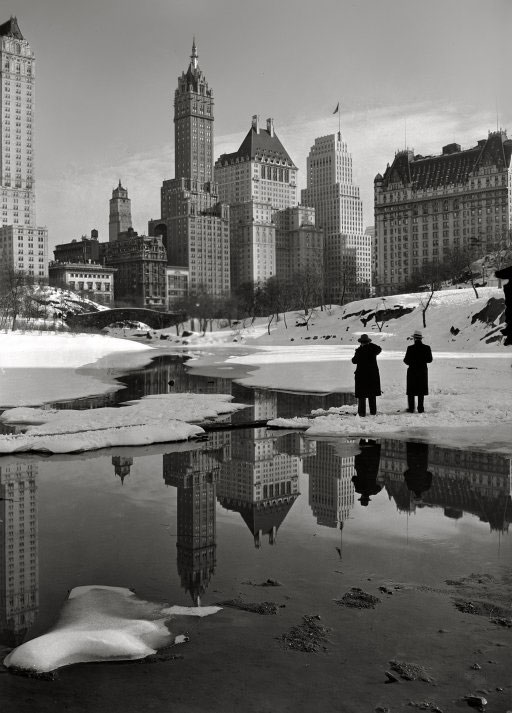
I'm not a New York person, but this view of the Savoy Plaza and other Midtown towers has got to be one of the most gorgeous cityscapes anywhere, ever. It was shot in Central Park in 1933 by architectural photographer Samuel Gottscho. Today, the view from the same spot would be dominated by tall glass office boxes; the Savoy and many of the other old towers have been demolished.
Gottscho worked as a traveling lace and fabric salesman for 23 years before he could work with his camera full time. He specialized in pictures of houses and gardens, but also branched out into nature photography.
A new novel by E.L. Doctorow uses a heavily photoshopped version of this picture on the cover.
New York
landscape
Manhattan
cityscape
Savoy Plaza
Central Park
(Image credit: Samuel H. Gottscho)
Aug 9, 2009
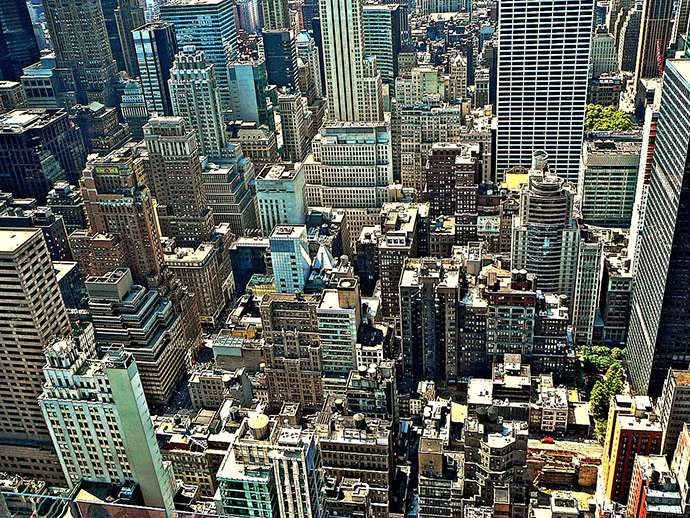
Midtown Manhattan, looking south from the 68th floor of Rockefeller Center.
New York
Manhattan
cityscape
birdseye view
(Image credit: Ellen Stein)
Feb 17, 2010
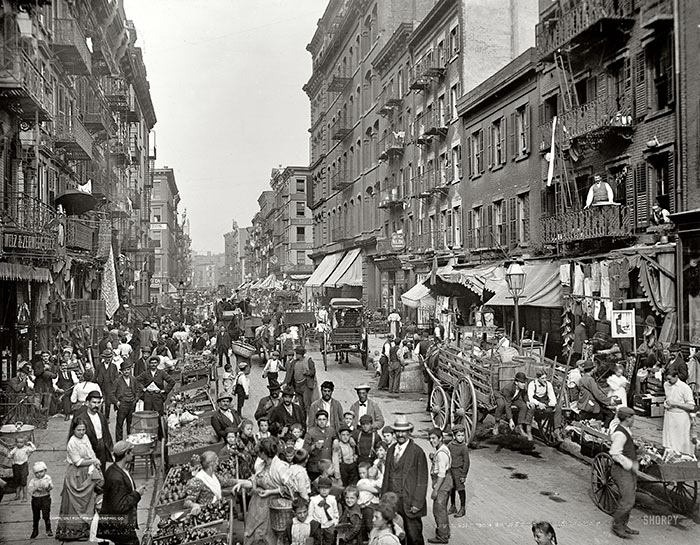
In 1900, Mulberry Street in lower Manhattan was the heart of Little Italy, where life was apparently lived out in the open, right in the street. Nowadays, cars instead of people dominate the street, and the people have retreated indoors, where apartments are much less crowded and much more likely to have indoor plumbing.
Click on this picture to see a much larger version, which you can mouse around in to appreciate the details of life in New York a century ago: the vegetable carts, the guy with a glass of beer in the middle of the street, the boy with his schoolbooks, the Banca Malzone, the aprons and wagons and fire escapes and . . .
New York
vintage
Manhattan
streetscape
Little Italy
(Image credit: Detroit Publishing Co., via Shorpy)
Nov 15, 2012
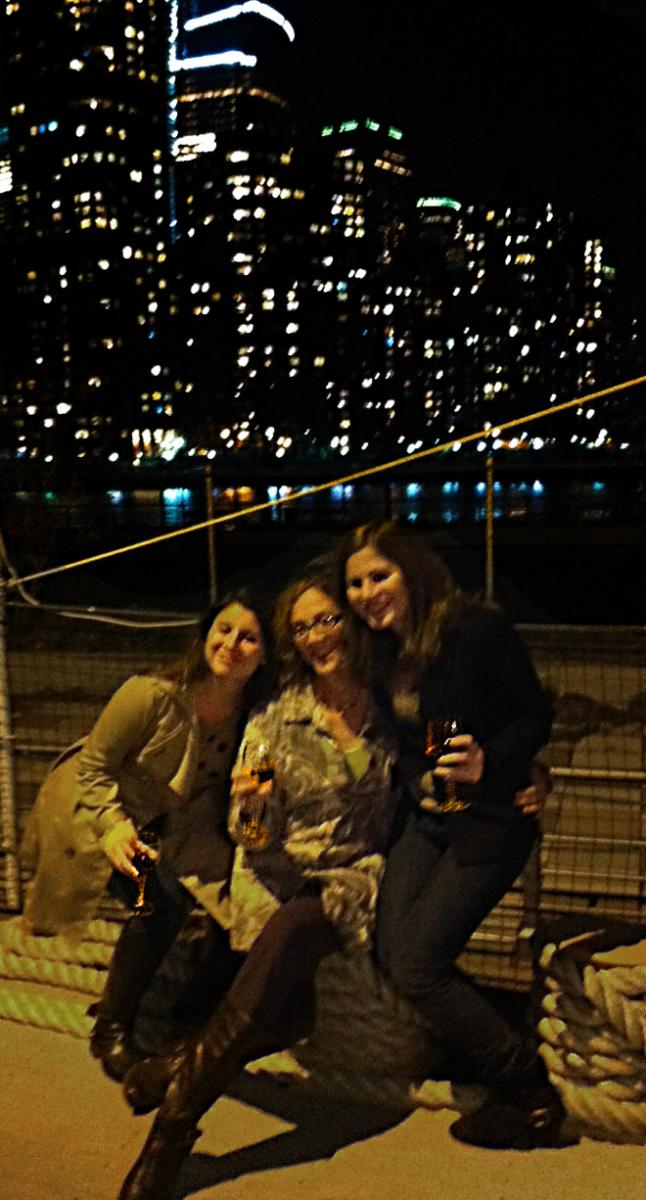
New York and New Jersey are mostly back on the grid, we hear, though there are stories, still, of people stranded in the cold and dark ever since that storm called Sandy. But last weekend, these electric Stein women–Amelia, Maggie, and their mother Sue–lit up Manhattan as they swept into town with glowing high spirits.
On the lightship Nantucket, we're told, docked at Pier 24 in TriBeCa, something was going on that involved wineglasses. Maggie, the daughter described by her mother as a "crafty sailor," apparently did a creditable turn at the ship's wheel without even setting down her glass. "Bet they don't teach that at Annapolis," observed Sue.
Manhattan
cityscape
night
lights
waterside
Amelia
Sue
Maggie
Feb 24, 2013

One thing we have in abundance in America is abandoned railroad tracks. Many thousands of miles have been torn up and paved over with asphalt, repurposed for walking and biking through cities and suburbs. Many of these rails-to-trails are pleasant amenities, but few are interesting to look at or exciting to experience. Today, we turn our eyes to a few of those few.
New York City's High Line Park, which we last visited back in 2011, is a garden in the sky, snatched from the ruins of an industrial el line that once carried cattle and chickens to the slaughterhouses of lower Manhattan's Hudson riverfront. Both the industrial roots and the post-industrial decline are celebrated in the park: everywhere, the grit and grunge, patched brick walls and rusted steel fixtures, are lovingly preserved, with landscaping that looks a lot like weeds and old-looking new (creosote-free) train tracks in the flower beds. Amongst the weeds are miles of boardwalk for strolling and people-watching.
This photo was taken from the High Line's amphitheater, a performance space cantilevered out over Tenth Avenue, with glass walls that keep the sounds of the city at bay. Down below, about a block away on the left side of the street, you can glimpse the edge of a parking lot that is also being reimagined as performance space, for a senior project by a Parsons School of Design student, our own Amelia Stein. All of us Hole-in-the-Cloudsians are eager to follow the progress of this work by one of our own.
Manhattan
cityscape
streetscape
New York City
High Line Park
(Image credit: Amelia Stein)
Nov 6, 2014
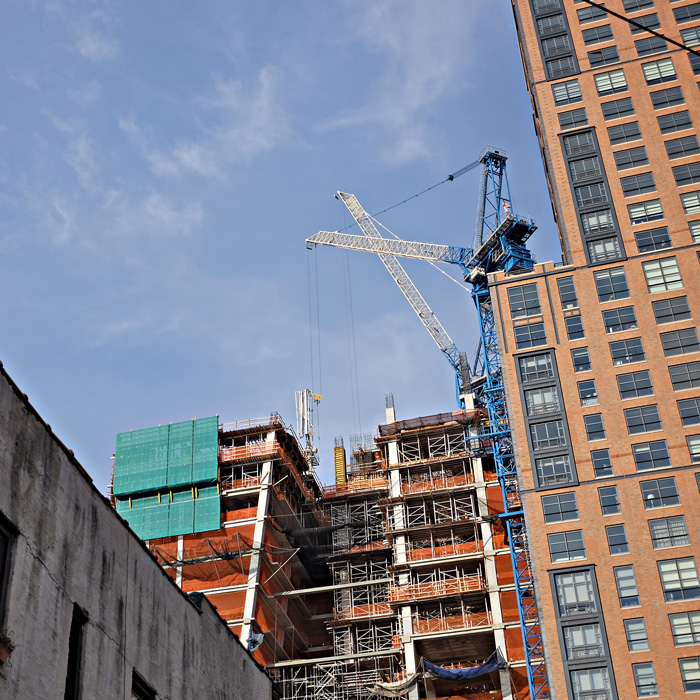 Two cranes get their act together high in the sky above New York City's High Line promenade.
Two cranes get their act together high in the sky above New York City's High Line promenade.
Many, many cranes are hard at work these days in that neck of the woods; apparently, real estate developers are firmly of the opinion that people will pay even more than the usual Manhattan rates to live in an apartment or condo near the High Line. They may be right; nobody's yet found the ceiling on what New Yorkers will pay for anything.
New York
Manhattan
cityscape
cranes
skyline
skyscrapers
High Line
(Image credit: Fuji T)
Nov 21, 2014
 Fulton Center, a new transit hub connecting four subway lines in lower Manhattan, opened to the public last week.
Fulton Center, a new transit hub connecting four subway lines in lower Manhattan, opened to the public last week.
Manhattan
New York City
subway
train station
(Image credit: Bob Tullis)
Apr 11, 2015
 One week ago, on a chilly but sunny New York afternoon, this espaliered pear tree in the Cloisters medieval garden was trying really, really hard to leaf out.
One week ago, on a chilly but sunny New York afternoon, this espaliered pear tree in the Cloisters medieval garden was trying really, really hard to leaf out.
Manhattan
garden
tree
spring
New York City
medieval
wall
Cloisters
(Image credit: Fuji T)
Apr 20, 2015
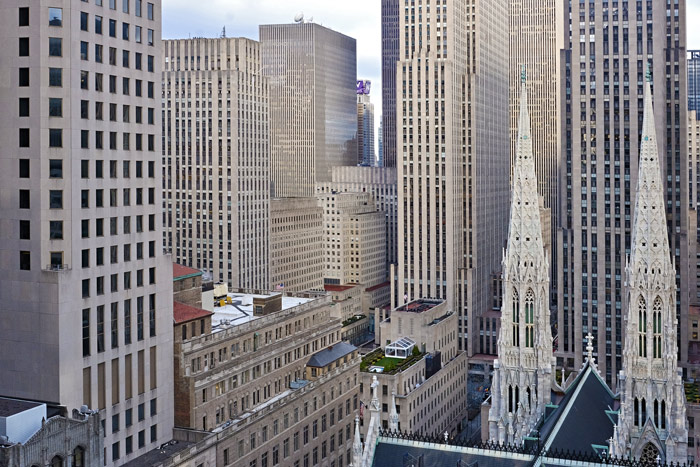 St. Patrick's Cathedral from behind and a little bit above, in midtown Manhattan. We enjoyed this view from the window of our hotel room during a recent trip to New York.
St. Patrick's Cathedral from behind and a little bit above, in midtown Manhattan. We enjoyed this view from the window of our hotel room during a recent trip to New York.
New York
Manhattan
skyline
skyscrapers
rooftops
St. Patrick's Cathedral
midtown
spires
(Image credit: Fuji T)
Mar 12, 2016
 Mandrake, a plant of biblical, medieval, literary, medical, and comic book significance, blooms in April in New York City, in the garden of the Cloisters at the northern tip of Manhattan.
Mandrake, a plant of biblical, medieval, literary, medical, and comic book significance, blooms in April in New York City, in the garden of the Cloisters at the northern tip of Manhattan.
Mandrake flowers, shown here as buds just beginning to open, are pretty little bell-shaped blossoms, but they are traditionally of little interest. The leaves are heavy and heart-shaped and can grow huge over the course of a summer, but they too are mostly overlooked. With mandrake, a plant native to the Mediterranean region, it's all about the root.
Mandrake root is long and thick and often split into two legs, sometimes arguably resembling the human form. It's also powerfully sleep-inducing when ground and soaked; it was used as an anesthetic in antiquity and into the Middle Ages. In the bible, and perhaps also in the poetry of John Donne, extract of mandrake root cured infertility. In folklore all over Europe, a human-shaped mandrake root in your pocket offered protection even if the church was not on your side; Joan of Arc was charged with "habitually" carrying root of mandrake.
Mandrake was said to spring up in ground drenched with blood or semen from a man being hanged. If you pulled the plant up out of the ground, as Shakespeare warned us, its man-root would scream, and you could die from hearing the scream. There was a report as late as the ninteenth century of a British gardener falling down the stairs and dying after accidentally pulling up a volunteer mandrake.
(In Harry Potter, of course, young witches and wizards wore protection.)
In 1934, "Mandrake the Magician" emerged as the world's first modern costumed superhero, in a newpaper comic strip that ran continuously until 2013. The hero Mandrake's ability to instantly hypnotize bad guys may have been, pardon the expression, rooted in the medicinal tradition of the mandrake plant.

Manhattan
garden
flowers
New York City
plants
Harry Potter
mythology
The Cloisters
mandrake
Ron Weasley
Jan 12, 2017
 When Italian architect Renzo Picasso visited New York City in the 1920s, he correctly identified traffic and parking as bad problems that would become much worse over time.
When Italian architect Renzo Picasso visited New York City in the 1920s, he correctly identified traffic and parking as bad problems that would become much worse over time.
There was no more land in Manhattan to pave over, so Picasso (no relation to that Spanish guy) took his cue from the skyscrapers and proposed to build the streets up vertically. He envisioned at least four transportation levels: trains up on top, express automobile traffic on the layer second to top, parking on the level below that, and local traffic on the bottom.
Picasso's vision for this American Multiple Highway, which he presented in 1929, was one of many utopian projects he sketched out for cities in the United States and Europe. None of them was ever built.
Manhattan
New York City
map
1929
Renzo Picasso
transportation
(Image credit: renzopicasso.com)












 When Italian architect Renzo Picasso visited New York City in the 1920s, he correctly identified traffic and parking as bad problems that would become much worse over time.
When Italian architect Renzo Picasso visited New York City in the 1920s, he correctly identified traffic and parking as bad problems that would become much worse over time.